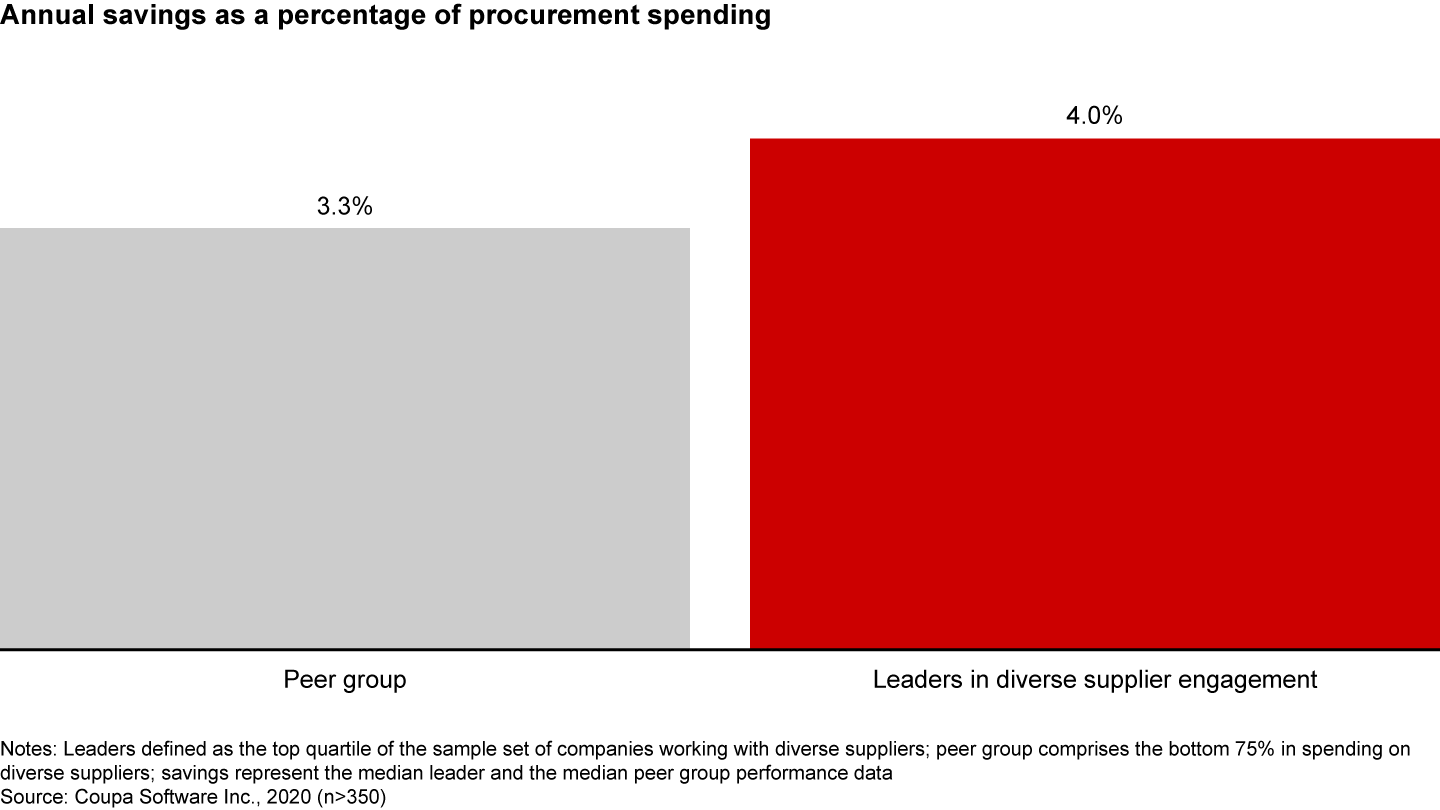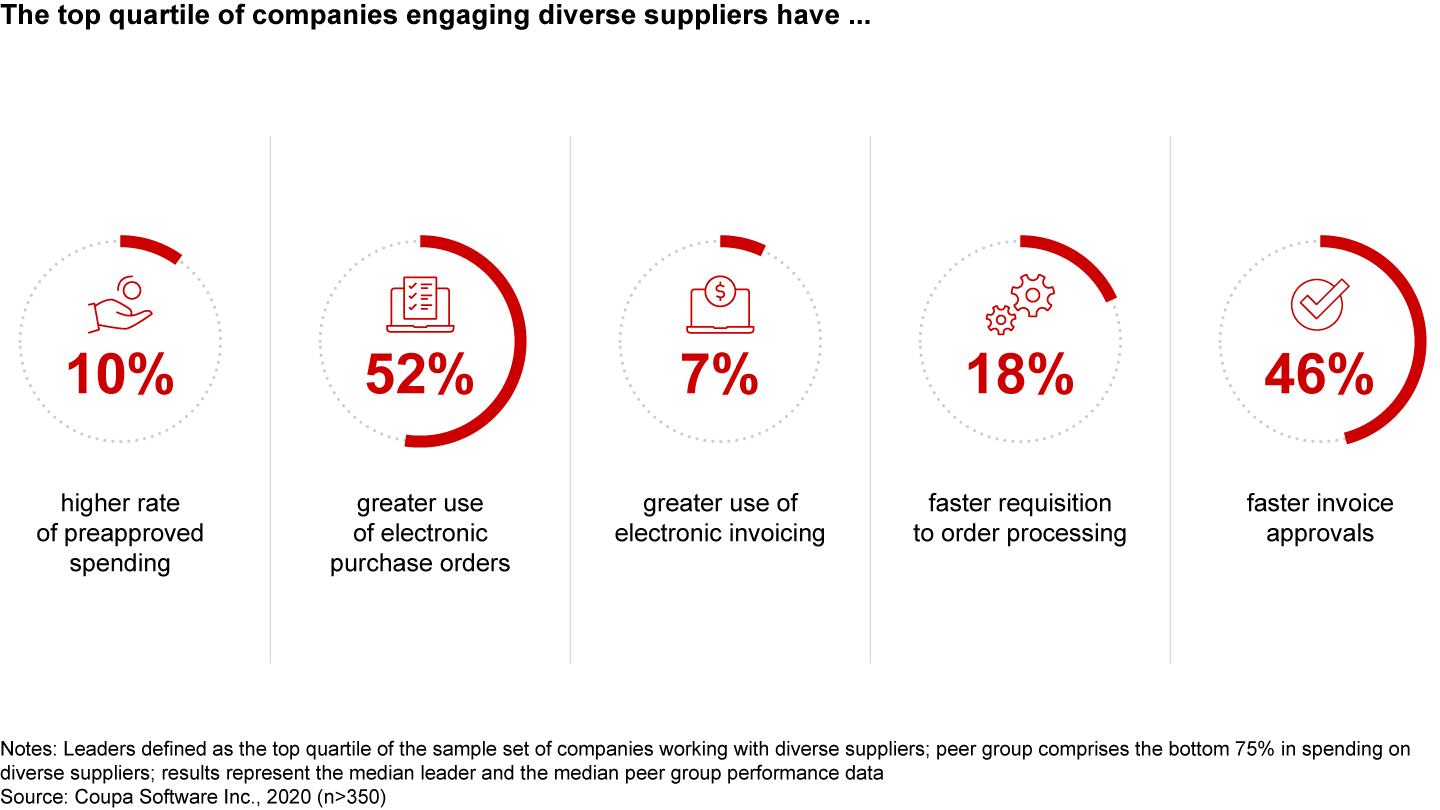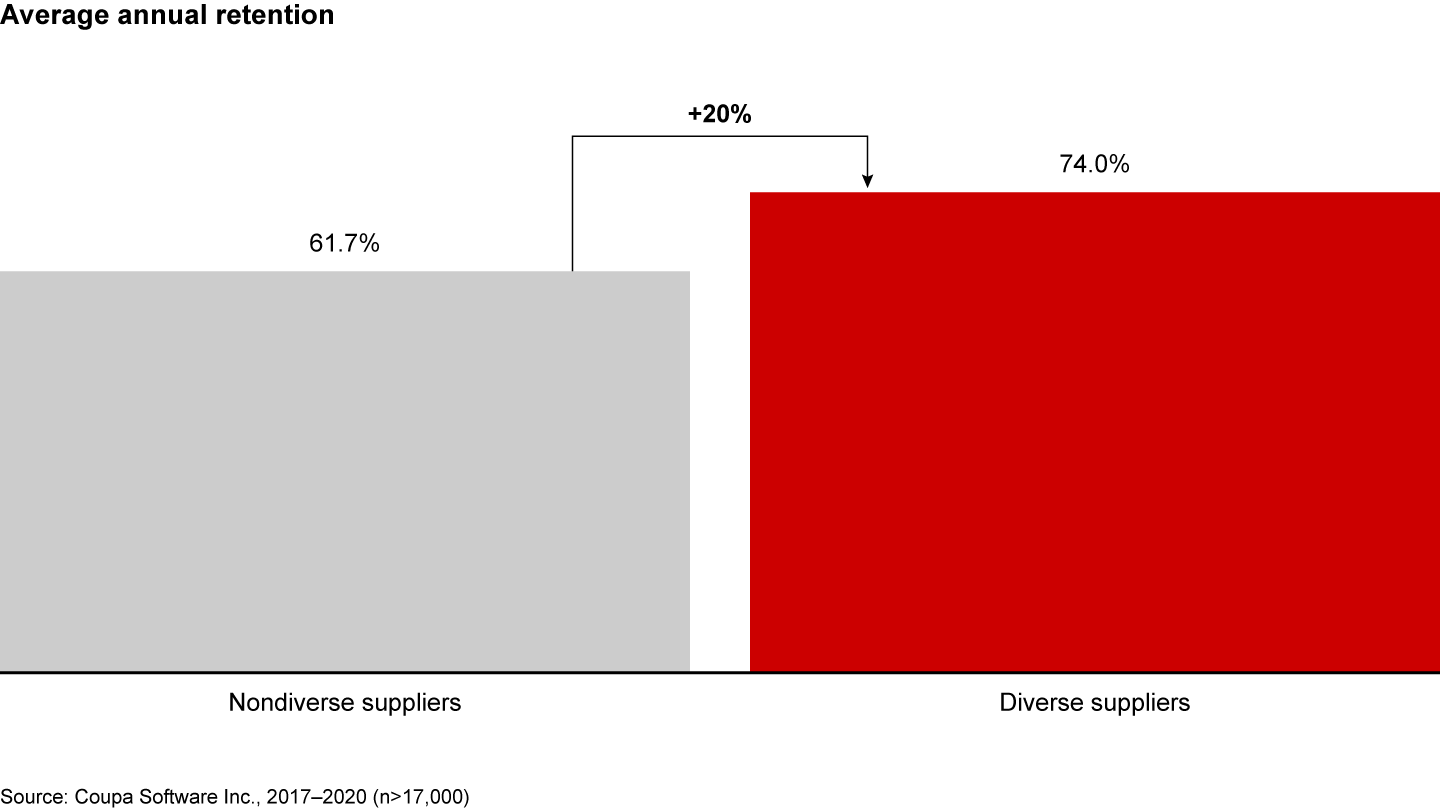Brief

At a Glance
- Despite strong commitment from the C-suite, many companies struggle to achieve their supplier diversity objectives.
- Diversity leaders dedicate sufficient resources to building an inclusive supply chain; they also create accountability.
- Leadership teams may have to overcome the mistaken belief that diverse suppliers are scarce and are not competitive on quality and cost.
- Companies in the top quartile of spending on diverse suppliers save an additional 0.7 percentage points in total procurement expenditures.
Supplier diversity has become a top priority for corporate boards in the US. The wave of national protests against systemic racism in 2020 prompted leadership teams to increase their engagement with businesses owned by Black people, women, and other underrepresented groups.
Written in collaboration with
Written in collaboration with

New commitments are broadening efforts launched in the 1960s by a number of large US companies to support supplier diversity. Spending on diverse suppliers rose an average of 54% between 2017 and 2020, according to Coupa, a company specializing in business spend management. And the pool has grown substantially. Minority-owned businesses—a large subset of the base of diverse enterprises—make up 18% of all US businesses, according to the US Census Bureau’s latest Annual Business Survey. The National Minority Supplier Development Council reports that certified minority-owned businesses generate more than $400 billion in annual revenue.

Doing Well Doing Good
Overcoming Obstacles to Make Supplier Diversity a Top Priority.
There’s no question that a diverse supplier base is good for society, but a growing number of executives confirm that it improves business performance too. UPS, Target, Pacific Gas and Electric, and other leaders have been building more diverse supplier pools for decades, a move that benefits their bottom lines and reduces supplier turnover. Companies that make up the top quartile in percentage of spending on diverse suppliers generate more procurement savings than the average company engaging diverse suppliers, Coupa’s research shows (see Figure 1).


Many companies assume that working with diverse suppliers will make them less efficient, but the data from Coupa shows that doesn't seem to be the case. The leaders in supplier diversity rely to a greater degree on electronic purchase orders and invoicing, and they benefit from doing a higher volume of work with contracted vendors. They also are faster at invoice approval and order processing (see Figure 2). Diverse suppliers have an annual retention rate that is 20% higher, on average, than nondiverse suppliers (see Figure 3).




But building a more diverse supplier base isn’t a quick or easy effort. Despite strong commitment from the board and the C-suite, many companies struggle to achieve their supplier diversity objectives. In our experience, leadership teams that succeed overcome a few key obstacles to change and make sure initiatives have staying power.
Understanding four key hurdles to success can help leadership teams achieve ambitious diversity goals. Below we examine these hurdles, and the companies that are at the forefront of engaging diverse suppliers.
Standalone initiatives
Many leadership teams eager to embrace supplier diversity limit their efforts to a series of short-term strategic sourcing events. That approach may provide a quick introduction to a potential pool of diverse enterprises. But standalone initiatives typically don’t address the long-term engagement required to develop a sustainable pipeline of diverse suppliers. For example, it typically takes 12 to 18 months to fully qualify a new supplier.
Tactical initiatives often lack focus, resources, and accountability because they are not part of the firm’s broader procurement or commercial strategy. Managers in charge of identifying and qualifying diverse suppliers typically don’t have sufficient funding to do so. Supplier diversity targets that are not included in the company’s standard category-management sourcing processes are likely to fade as a priority over time.
Retail giant Target overcame the challenge by integrating supplier diversity goals into its commercial strategy. That move helped the company double spending on diverse Tier 1 and Tier 2 suppliers to $2 billion between 2016 and 2019. When Target organizes and hosts events to identify diverse businesses for specific product lines, for example, procurement staff help potential suppliers get certified and grow. The company’s supplier diversity team holds business fairs at its Minneapolis headquarters that give diverse vendors an opportunity to present their products to Target’s buyers alongside traditional suppliers. At a beauty innovation fair in 2014, 70% of the diverse vendors who participated won business from Target.
Lack of organizational alignment
Companies often fail to achieve their supplier diversity goals because competing firm priorities take precedence. Procurement executives tasked with implementing diversity initiatives, for instance, must also meet targets for speed and quality. Faced with the potential risks and delays of bringing a new supplier on board, it’s all too easy to stick with an incumbent.
Boards make strong commitments to increasing supplier diversity but may overlook vital changes in the day-to-day decisions that are critical to implementation. Business units need a mandate to channel procurement spending to a new set of unknown suppliers—and a clear sense of how diversity goals stack up against other competing priorities. Leadership teams may also have to overcome the mistaken belief that diverse suppliers are scarce and don’t cover all categories, and that they are not competitive on quality and cost.
UPS spends $2.6 billion annually on contracts with 6,000 small and diverse suppliers and is committed to growing that pool. To strengthen organizational alignment, the leadership team established a diversity and inclusion council that oversees execution, ensuring executives meet the board’s objectives to increase annual spending on diverse suppliers. The council helps identify conflicts in messaging and processes, and it was instrumental in convincing key stakeholders, including other business units and functions, to view diverse suppliers as potential sources of innovation.
Lack of dedicated resources
Diverse suppliers often are smaller businesses that require support to succeed and grow. One of the key reasons supplier diversity initiatives flounder is that organizations underinvest in the capabilities required to support new or developing suppliers, including onboarding, risk mitigation, and mentoring. In-house coaching is critical because each procurement organization’s requirements are unique.
UPS addressed this challenge by dedicating resources to in-house programs to support supplier diversity. Designated employees review products and services provided by diverse suppliers for potential business opportunities. And when diverse suppliers qualify to do business with UPS, the company helps them meet the firm’s product specifications. It also pledges to review applications and certifications rapidly.
Goals limited to Tier 1 spending
Leadership teams seeking to build a more diverse supplier base typically target the Tier 1 supplier pool and don’t take the next step of increasing diversity among Tier 2 suppliers—or broadening the scope of their commitment to work with companies that may not have a minority owner but excel at diversity in hiring, leadership training, and organizational culture. A narrow focus on Tier 1 spending restricts the ability to grow a diverse supplier ecosystem and may render company targets unsustainable. It also reduces the full potential benefits of working with a diverse supplier group, including collaboration and innovation as well as access to new markets, customers, and services.
Leaders in supplier diversity implement a multiyear vision that reaches beyond Tier 1 suppliers. They also broaden their search for diverse suppliers to include public companies that are dedicated proponents of supplier diversity based on their policies, actions, and reporting practices. Leading companies with a mandate to improve diversity rethink how they track their own progress beyond dollars spent with diverse suppliers. Some are working with firms like EcoVadis to assess suppliers’ diversity and inclusion practices.
General Motors spends more than $7 billion annually on contracts with diverse suppliers, including $3.5 billion on Tier 2 suppliers. Over time, that approach has delivered a series of product development innovations, including a reclassification of its Chevy Cruze model. Detroit Technologies, Inc. (DTI), a 51% Black-owned joint venture, assisted in the redesign of the 2010 Cruze, enabling GM to classify the vehicle as midsize according to US Environmental Protection Agency standards. In order to meet agency requirements, DTI provided program and engineering resources and reduced tooling lead time from 22 weeks to 8 weeks.
Supplier diversity initiatives can deliver powerful advantages. But companies with the most ambitious commitments to building an inclusive supplier base also know that creating the right foundation for success takes time, commitment, and organizational change. These leaders integrate supplier diversity initiatives into the firm’s broader strategy, ensure organizational alignment, commit sufficient resources to build new capabilities, and look beyond the Tier 1 supply base to develop a deep and sustainable supplier ecosystem.

About Coupa Software
Coupa empowers companies around the world with the visibility and control they need to spend smarter and safer. To learn more, visit www.coupa.com.

Four Ways to Build a More Inclusive Supplier Base
Many companies struggle with meeting their supplier diversity objectives, but leaders have learned how to overcome the obstacles.